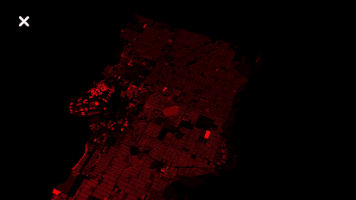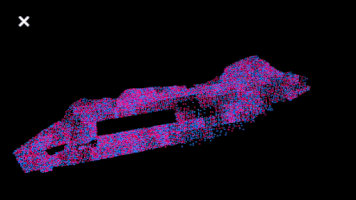This is an open-source C++ implementation of deck.gl.
This project is no longer active. It was an experiment to understand what it would take to build a native version of deck.gl. There are discussions about restarting a deck.gl-native effort (this time probably in Rust instead of C++) to help us integrate more non-JavaScript code, better support mobile platforms, and collaborate better with basemaps like maplibre-gl. If you have more than a passing interest in this topic you are welcome to join us at https://www.openvisualization.org/#get-involved.
| Layer examples running on an iOS device | ||
|---|---|---|

LineLayer + ScatterplotLayer |

SolidPolygonLayer |

ScatterplotLayer |
This project targeted a minimal, proof-of-concept prototype. This initial deck.gl-native release is unlikely to meet the requirements of most applications.
- Render to texture (not screen)
- Support deck.gl JSON API
- Layers: Only
ScatterplotLayer,LineLayer,SolidPolygonLayer - Tables: Only Apache Arrow tables will be supported, apps will need to use Arrow libraries if data is not already in Arrow format.
- loader support will be limited to CSV and line-delimited JSON.
- iOS only: will only be tested on iOS (no serious attempts will be done to make deck.gl-native work on other platforms).
Many features normally considered fundamental by deck.gl applications are not even being addressed at this stage
- No Render to screen
- No Transitions
- No Base map support (e.g. Mapbox integration)
- No Interactivity (event handling, picking etc)
- No Extensive layer catalog
- No Performance Optimizations
- etc
- iOS12+ is required when building for a device
- iOS13+ is required when building for a simulator, as
Metalis available on the simulator starting with iOS13 - Currently has to be built with bitcode disabled (under investigation)
- macOS10.14+
- Tested and runs on Ubuntu Bionic
To get oriented on the deck.gl software architecture:
- deck.gl Technical Deep-Dive is a good initial read. Written for the JavaScript version, however most concepts apply directly to the C++ port as well.
- deck.gl cross-platform architecture describes approaches to keeping multi-language implementations of deck.gl compatible (still a work-in-progress but gives a sense of the higher level direction).
A primary concern for the deck.gl-native port, especially once it matures, is how to keep it develop in sync with the various implementations and variants of the deck.gl API, such as the core JavaScript codebase, the pydeck Python API etc.
Currently the two main guidelines are:
- deck.gl JSON parity The deck.gl JSON API (See e.g. deck.gl playground) is the "common API" that will be supported by both the JavaScript and C++ implementations of deck.gl. This help ensure that both the C++ and JavaScript renderers evolve in sync, always providing compatible features (when their layer catalogs overlap etc).
- module and class parity Within reason, the same modules, classes (and often even filenames) are used in both implementations. This 1-to-1 mapping really helps developers move quickly between the two code bases.
Beyond the above rules, it is certainly acceptable C++ and JavaScript APIs to diverge, as long as it makes sense, to ensure they are both natural to use for programmers with backgrounds in the respective programming language. (E.g. functional style UI programming is common in the JS community while C++ programmers on the balance are likely favor a more imperative API style).
Top-level API also includes exception-less counterparts for core functionality across the modules.
The deck.gl-native code bases exposes a set of C++ "module header files" following a <framework>/<module>.h structure.
| Module | Description |
|---|---|
probe.gl/core.h |
Platform/Compiler detection, assertions, logging and timers |
math.gl/core.h |
Vectors and Matrices |
math.gl/web-mercator.h |
Geospatial math for Web Mercator projection |
loaders.gl/csv.h. |
A CSV table loader |
loaders.gl/json.h. |
A JSON table loader |
luma.gl/core.h |
Model, AnimationLoop etc implemented on dawn API |
luma.gl/webgpu.h |
Internal utilities for working with the WebGPU API (adaptions from the dawn repo) |
luma.gl/garrow.h |
GPU-based implementation of Arrow-like API |
deck.gl/core.h |
The core deck.gl classes:\ Deck, Layer, View, etc. |
deck.gl/layers.h |
The initial layer catalog |
deck.gl/json.h |
Classes for parsing (deck.gl) JSON into C++ objects |
Remarks:
- The
frameworkpart of the C++ module header file name corresponds on the JavaScript side to a framework from the vis.gl framework suite, and themodulepart corresponds to a submodule in that framework monorepo. - Each of the modules is built as a separate library, in a format suitable for consumption on the OS it's being built for
All in-memory table processing is based on the Apache Arrow C++ API. This will be almost invisible to applications if they use the provided loaders, however for more advanced table processing applications may need to work directly with the Arrow API.
To get started with Arrow, useful resources might be:
- Arrow C++ API Docs
- Arrow Test Suite - Examples of working code.
CSV and JSON table loaders are provided as part of the deck.gl library. To support additional table formats, the envisioned approach is to implement additional "loaders" that load various formats and "convert" the loaded tables to Arrow representation.
deck.gl-native is being built on top of the C++ WebGPU API using the dawn framework.
The dawn framework is a compelling choice for deck.gl:
- The JavaScript version of deck.gl will inevitably move from WebGL to WebGPU, so having both C++ and JavaScript work against a common 3D API will signficantly increase the ease of aligning the JavaScript and C++ code bases.
- The Dawn project has the ambition to provide backends on basically all platforms/rendering APIs of interest, including Vulkan, Metal, D3D12, and OpenGL. Ideally meaning that deck.gl-native itself will only have to implement a single backend, namely dawn.
Note that Dawn is still a work in progress (with different levels of support for different platforms - the prototype is only being tested on iOS) and there is some risk with this technology choice. However, given the momentum behind WebGPU in browsers, we feel that the prospects are currently looking good.
This porting project is led by Unfolded, Inc, and currently relies on initial funding provided by a customer as well as external contributions. At this stage, this is not an fully or independenly resourced project. It only targets a proof-of-concept prototype, it does not have a maintenance plan and is not set up to address feature requests etc.
Our hope is to see this project quickly grow into a living part of the core deck.gl project. If this project reaches a sufficient level of completeness / critical mass, the ambition is to make this project part of the main deck.gl project and transfer it to an open governance setup.
Development can be done on macOS which is the primary environment, or Linux, which is supported mainly for CI testing. (Windows is not a supported dev env.)
NOTE: Building using gcc currently doesn't work, this is to be updated
If you haven't already configured Xcode:
- Install Xcode
- Launch it
- accept the license agreement
- Run
sudo xcode-select -s /Applications/Xcode.app(Subsitute with path to your Xcode app if different).
For macOS:
brew install clang cmake clang-format lcovFor macOS:
brew install gcc cmake clang-format lcovscripts/bootstrap.shto fetch the dependencies and perform setup.bootstrap.shcan/should be called after pulling a branch to ensure environment is up to datescripts/build-clangorscripts/build-gccto build
All the dependencies for macOS and Linux are bundled in a dependency repository that's being used as a submodule. Running scripts/bootstrap.sh, among other things, fetches all the submodules. Alternatively, you can fetch them by running git submodule update --init --recursive.
| Dependency | Description |
|---|---|
| Google Test | Testing framework |
| jsoncpp | JSON parser |
| arrow | Columnar in-memory storage |
| dawn | C++ WebGPU implementation with a maturing list of backends for most platforms |
| shaderc | GLSL shader compilation |
| glfw | Portable library for creating OS windows to render graphics in, and handling events |
mkdir build
cd build
cmake ..
make -j 16
To use different compilers, set the build options CMAKE_C_COMPILER and CMAKE_CXX_COMPILER on the cmake command line. There is a number of build scripts for different compilers available in scripts directory.
For Google Test formatted output, run ./deckgl-bundle-tests.
For CTest formatted output, run ctest.